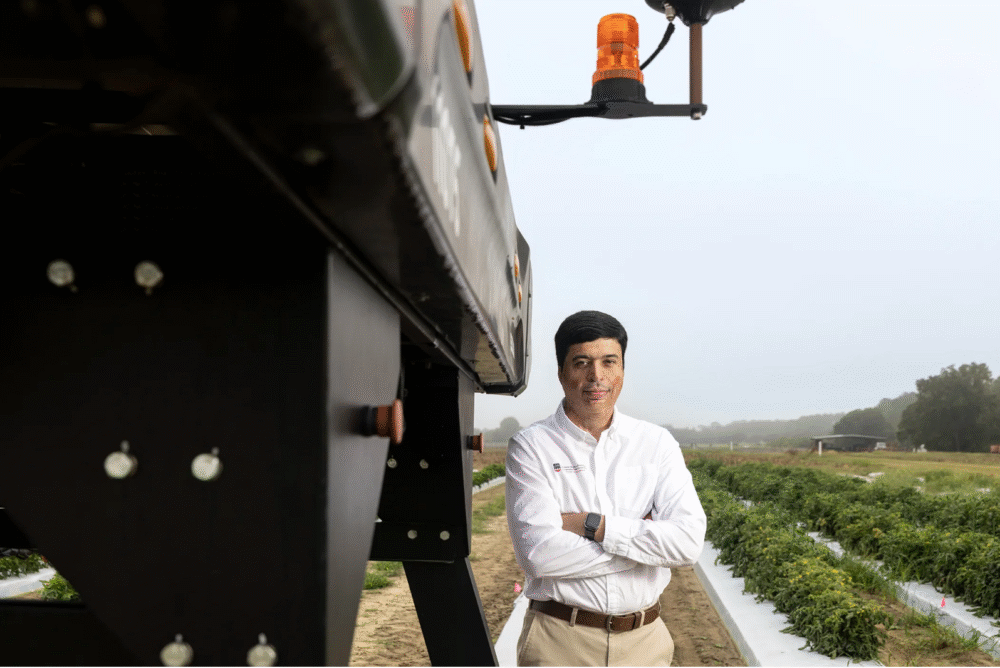By Gary L. Wade
University of Georgia

Volume XXVIII |
To most folks, the word palm triggers thoughts of Florida,
Hawaii or Georgia’s
coastal islands. But you don’t have to live in any of these
areas to enjoy palms.
A few cold-hardy palms will grow as far north as Tennessee
and North Carolina,
where the average winter may reach minus 10 degrees
Fahrenheit.
Palm varieties
Windmill palm (Trachycarpus fortunei) is one of the
hardiest. It will
grow throughout Georgia and has survived cold as low as minus
10. This January,
windmill palms in Athens, Ga., weathered 9 degrees without a
scratch.
This palm looks particularly nice in groups of three to five
at the corner
of a building or courtyard entrance. It’s great around
swimming pools, too,
because it doesn’t litter the water as deciduous trees do. At
20 to 25 feet
tall, it has fan-shaped leaves and a brown trunk covered with
burlap-like fibers.
Needle palm (Rhapidophyllum hystrix) is a clumping,
understory palm
with deep green, fan-shaped leaves. It’s a Southeastern native
and an endangered
species, with its native habitat increasingly destroyed by
development.
Its name stems from the many needle-like spines along its
petioles. These aren’t
a problem until pruning becomes necessary. Once established,
it’s a carefree
plant and one of the hardiest palms, surviving winters as low
as minus 5.
Surprisingly, needle palm does better inland than along the
coast (it doesn’t
like salt spray). It grows 5 feet tall and wide, so a single
specimen will fill
a large space. Some beautiful, old needle palms grow at
historic estates in
Madison, Ga.
Dwarf palmetto (Sabal minor) is native to Southeastern
river flood plains.
It grows 4 to 5 feet high and wide with green to blue-green
fronds. It’s not
as hardy as needle palm. But it’s been reported to withstand
temperatures down
to 10 degrees.
Each plant bears no more than six fronds, so it looks best
when planted in
clumps of three to five. It prefers moist, sunny sites.
Unlike the saw palmetto (Serenoa repens) that grows
rampantly in south
Georgia and Florida woodlands, dwarf palmetto isn’t invasive
and doesn’t have
needle-like spines.
Cabbage palm (Sabal palmetto) is also called palmetto
palm. The state
tree of South Carolina and Florida, it’s native to coastal
areas from North
Carolina to Florida. It’s found in the wild throughout the
Florida panhandle
and parts of south Georgia, too.
It usually can be grown without cold protection along a line
from Columbus
to Augusta. But cold protection is best to the north of that
line.
This means planting it in a sheltered courtyard or on the
southeast side of
a structure, where it’s sheltered from cold winter winds, and
wrapping the fronds
and center bud in blankets to protect them from temperatures
below 25 degrees.
A courtyard planting in Greensboro, Ga., contains some
beautiful cabbage palms.
Jelly palm (Butia capitata) is native to Uruguay and
southern Brazil
but is planted widely throughout Florida and coastal Georgia.
As the name implies,
its fruit is used to make jelly.
It grows up to 30 feet tall and bears blue-green, feather-
like fronds. Like
the cabbage palm, it requires winter protection when
temperatures drop below
25 degrees.
This involves tying the fronds together in bundles and
covering them with burlap
or blankets. Protecting the central bud is critical, because
that where new
growth starts.
Palm resources
The Southeast Palm and Exotic Plant Society has an excellent
reference manual
for growing palms in the Southeast. Get it from your county
University of Georgia
Extension office or at pubs.caes.uga.edu/caespubs/horticulture/Palmreader.html.
Some sources of cold-hardy palms include Woodlanders, Inc.,
in Aiken, S.C.;
Nurseries at North Glen in Glen St. Mary, Fla.; Plant Delights
Nursery in Raleigh,
N.C.; and Gerry’s Jungle in McDonough, Ga.




